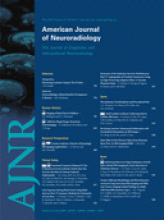Research ArticlePediatric Neuroimaging
Open Access
White Matter Characteristics and Cognition in Prenatally Opiate- and Polysubstance-Exposed Children: A Diffusion Tensor Imaging Study
K.B. Walhovd, L.T. Westlye, V. Moe, K. Slinning, P. Due-Tønnessen, A. Bjørnerud, A. van der Kouwe, A.M. Dale and A.M. Fjell
American Journal of Neuroradiology May 2010, 31 (5) 894-900; DOI: https://doi.org/10.3174/ajnr.A1957
K.B. Walhovd
L.T. Westlye
V. Moe
K. Slinning
P. Due-Tønnessen
A. Bjørnerud
A. van der Kouwe
A.M. Dale

References
- 1.↵
- Suess PE,
- Newlin DB,
- Porges SW
- 2.↵
- 3.↵
- Moe V
- 4.↵
- 5.↵
- Riley EP,
- McGee CL
- 6.↵
- Chang L,
- Smith LM,
- LoPresti C,
- et al
- 7.↵
- Walhovd KB,
- Moe V,
- Slinning K,
- et al
- 8.↵
- Walhovd KB,
- Moe V,
- Slinning K,
- et al
- 9.↵
- de Graaf-Peters VB,
- Hadders-Algra M
- 10.↵
- Sowell ER,
- Johnson A,
- Kan E,
- et al
- 11.↵
- Hu S,
- Sheng WS,
- Lokensgard JR,
- et al
- 12.↵
- 13.↵
- Stiene-Martin A,
- Knapp PE,
- Martin K,
- et al
- 14.↵
- Mori S,
- Zhang J
- 15.↵
- Wozniak JR,
- Lim KO
- 16.↵
- Ma X,
- Coles CD,
- Lynch ME,
- et al
- 17.↵
- Wozniak JR,
- Mueller BA,
- Chang PN,
- et al
- 18.↵
- Barkovich AJ,
- Kjos BO,
- Jackson DE Jr.,
- et al
- 19.↵
- Wechsler D
- 20.↵
- Finnegan LP,
- Kron RE,
- Connaughton JF,
- et al
- 21.↵
- Gillberg C,
- Cederlund M
- 22.↵
- Mitchell LE,
- Adzick NS,
- Melchionne J,
- et al
- 23.↵
- 24.↵
- Wielkiewicz RM
- 25.↵
- Smith SM,
- Jenkinson M,
- Woolrich MW,
- et al
- 26.↵
- Leemans A,
- Jones DK
- 27.↵
- Smith SM
- 28.↵
- Smith SM,
- Jenkinson M,
- Johansen-Berg H,
- et al
- 29.↵
- Rueckert D,
- Sonoda LI,
- Hayes C,
- et al
- 30.↵
- Andersson JLR,
- Jenkinson M,
- Smith S
- 31.↵
- Andersson JLR,
- Jenkinson M,
- Smith S
- 32.↵
- Wakana S,
- Caprihan A,
- Panzenboeck MM,
- et al
- 33.↵
- Mori S,
- Wakana S,
- Nagae-Poetscher LM
- 34.↵
- Hua K,
- Zhang J,
- Wakana S,
- et al
- 35.↵
- Westlye LT,
- Walhovd KB,
- Bjørnerud A,
- et al
- 36.↵
- Bendersky M,
- Musolino PL,
- Rugilo C,
- et al
- 37.↵
- Song SK,
- Sun SW,
- Ramsbottom MJ,
- et al.
- 38.↵
- Song SK,
- Yoshino J,
- Le TQ,
- et al
- 39.↵
- Song SK,
- Sun SW,
- Ju WK,
- et al
- 40.↵
- Garcia-Fuster MJ,
- Ramos-Miguel A,
- Rivero G,
- et al
- 41.↵
- 42.↵
- 43.↵
- Chang KJ,
- Cooper BR,
- Hazum E,
- et al
- 44.↵
- Kinney HC,
- Brody BA,
- Kloman AS,
- et al
- 45.↵
- Kinney HC,
- Karthigasan J,
- Borenshteyn NI,
- et al
- 46.↵
- Barkovich AJ
- 47.↵
- Tuch DS,
- Salat DH,
- Wisco JJ,
- et al
- 48.↵
- Turken A,
- Whitfield-Gabrieli S,
- Bammer R,
- et al
- 49.↵
- Derauf C,
- Kekatpure M,
- Neyzi N,
- et al
- 50.↵
- Chiang MC,
- Barysheva M,
- Shattuck DW,
- et al
- 51.↵
- Casey BJ,
- Epstein JN,
- Buhle J,
- et al
In this issue
Advertisement
K.B. Walhovd, L.T. Westlye, V. Moe, K. Slinning, P. Due-Tønnessen, A. Bjørnerud, A. van der Kouwe, A.M. Dale, A.M. Fjell
White Matter Characteristics and Cognition in Prenatally Opiate- and Polysubstance-Exposed Children: A Diffusion Tensor Imaging Study
American Journal of Neuroradiology May 2010, 31 (5) 894-900; DOI: 10.3174/ajnr.A1957
0 Responses
White Matter Characteristics and Cognition in Prenatally Opiate- and Polysubstance-Exposed Children: A Diffusion Tensor Imaging Study
K.B. Walhovd, L.T. Westlye, V. Moe, K. Slinning, P. Due-Tønnessen, A. Bjørnerud, A. van der Kouwe, A.M. Dale, A.M. Fjell
American Journal of Neuroradiology May 2010, 31 (5) 894-900; DOI: 10.3174/ajnr.A1957
Jump to section
Related Articles
Cited By...
- A Prospective Multi-Institutional Study Comparing the Brain Development in the Third Trimester between Opioid-Exposed and Nonexposed Fetuses Using Advanced Fetal MR Imaging Techniques
- DTI of Opioid-Exposed Fetuses Using ComBat Harmonization: A Bi-Institutional Study
- Consequences of Parental Opioid Exposure on Neurophysiology, Behavior, and Health in the Next Generations
- White Matter Injury and Structural Anomalies in Infants with Prenatal Opioid Exposure
- Multimodal imaging of the self-regulating developing brain
This article has not yet been cited by articles in journals that are participating in Crossref Cited-by Linking.
More in this TOC Section
Similar Articles
Advertisement











